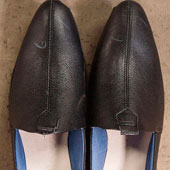Design Resource
Shoe Making - Agra
Shoe is associated with mankind
by
Shoes are generally made of sole, insole, outsole, midsole, heel and vamp as basic parts. Sole is the exterior part, which is present at the bottom of shoe. Insole is present inside the shoe, which come under direct contact of foot. Outsole is a part which come under direct contact with ground. Midsole is present between the outsole and insole, which helps in shock absorption. Heel is a part which is attached to the rear end of shoe. Vamp which is also known as upper, its helps to hold the shoe on the foot and also it is the top part of the shoe. Making of shoe is divided into four different segments cutting process, machining (closing) process, machining process, Lasting process and finishing proces.
Cutting process is used to make to uppers for the of the shoe, generally cow leather is used to make the upper of the shoe but any other type of leather can also be used depending on customers’ demands. Metal strip knives are used to cut the required shape out of leather. This part of the process is very important, as it requires lot of experience to cut the leather with minimum wastage. Careful inspection of leather is required as it may be damaged while transporting and such parts cannot be used for making shoes. Machine process is done to stitch the upper together, all the parts of upper is stitched on a flat base machine, once the stitching of upper is completed, from flat leather piece it become 3 dimensional in nature, taking the shape of foot. To stitch a 3 dimensional upper, machine known as post machine with elevated surface is used. Various design are also done on the upper at this stage and eyelets are attached in this stage, through which laces are passed.
Lasting process is done to shape the upper into required foot size, which is done with the help of plastic last, which resembles the shape of foot. Insole of the shoe is temporarily attached to the bottom of last. Upper is stretched and molded on top of last to which welt- a thin strip of leather is sewn. Upper and extra materials are trimmed. Welt and insole is sewn together, followed by outer sole and in last heels. Finishing process is mainly done for leather shoe, the sole edge and heel are trimmed and buffed for a smoother, attractive and waterproof finish. They are stained, polished and waxed. Pure leather shoes are much more costly then synthetic leather, the amount required to manufacture 100 leather shoes is equal to the amount required to manufacture 600 synthetic leather shoe.


































